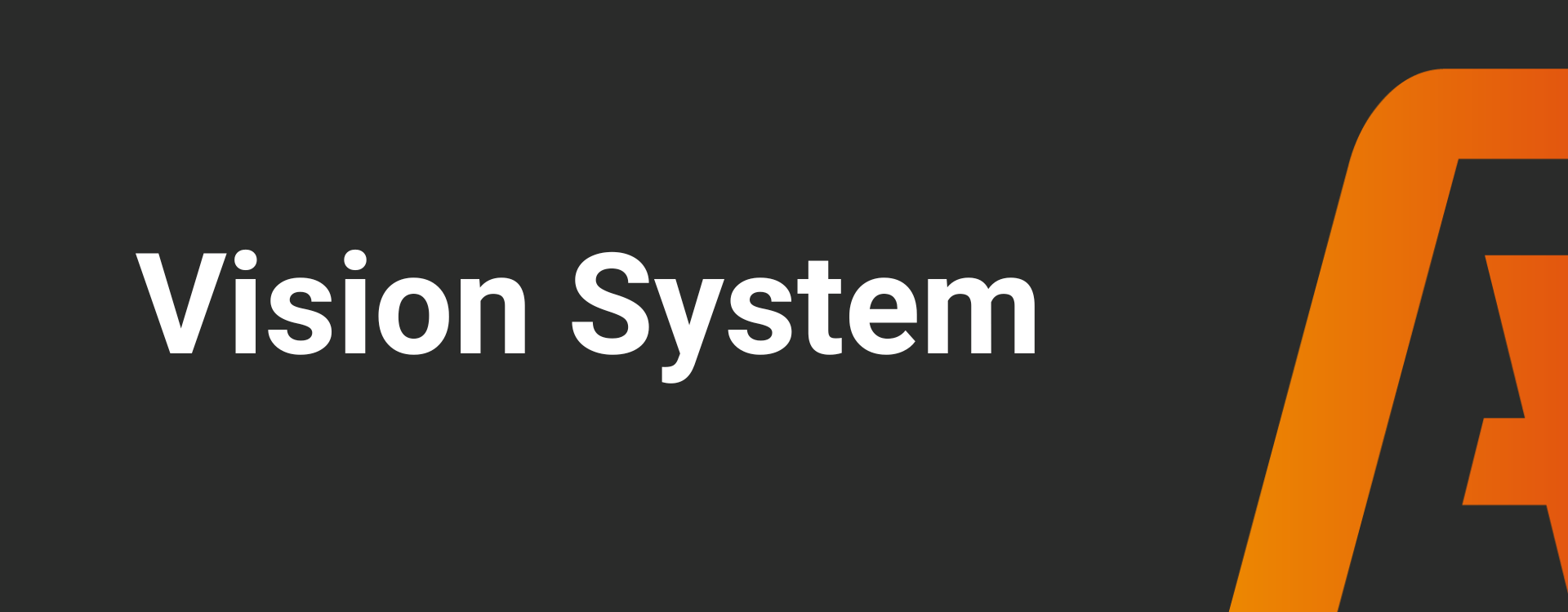» What is a vision system?
» How does a vision systeem?
» What are the benefits of implementing vision?
» What is vision used for?
» Is it difficult to implement a vision system?
» What types of cameras are used in vision systems?
» What are trends and developments in the world of vision?
» How do you implement a vision system?
» Vision system and Ignition
» Explore Ignition
Other knowledge base articles

Vision system
» What is a vision system?
» How does a vision system work?
» What are the benefits of implementing vision?
» What is vision used for?
» Is it difficult to implement a vision system?
» What types of cameras are used in vision systems?
» What are trends and developments in the world of vision?
» How do you implement a vision system?
» Vision system and Ignition
» Explore Ignition
What is a vision system?
A vision system, also known as a machine vision system, is an automated system that utilizes image processing technologies to obtain and analyze visual information. It is a form of AI (Artificial Intelligence) that enables computers to understand images and convert them into usable data.
A vision system typically consists of various components, including a camera or a series of cameras, a light source, image processing software, and often a processor and memory to execute the image processing algorithms. The system can be integrated into various types of devices and machines, such as production lines, robots, quality control systems, and medical diagnostic systems.
Using vision systems, machines and systems perform visual inspections on products and materials, detect defects, conduct measurements, and collect data for further analysis. This helps improve the productivity and efficiency of production lines, reduce waste and errors, and enhance the quality of products.
How does a vision system work?
A vision system utilizes cameras, image processing, and pattern recognition technology to obtain and analyze visual information. It works by capturing images of an object or scene using cameras mounted in suitable locations. Subsequently, it processes and analyzes the captured image information to extract key features and recognize patterns.
The process of extracting key features often involves the use of image processing techniques. These techniques enable the isolation of objects and determination of key features such as size, shape, color, and texture.
Next, it compares the extracted information with known patterns and models to determine whether the object meets certain criteria or not. This includes, for example, determining whether a product is manufactured correctly or whether a specific component is installed properly.
The ultimate goal of a vision system is to perform fast, accurate, and consistent inspections and ensure product quality. This saves costs by reducing waste and product defects and increases production efficiency.
What are the benefits of implementing vision?
- Accuracy: They perform and measure inspections with high precision. This improves product quality and reduces defects.
- Speed: They perform inspections much faster than manual inspections. This increases production efficiency and shortens lead times.
- Consistency: They always perform inspections in the same manner, ensuring consistent results. This guarantees product quality and reduces variation.
- Automation: They can be integrated with production lines and automation systems, allowing inspections to be performed automatically without operator intervention. This improves efficiency and productivity.
- Cost Savings: Due to the accuracy, speed, consistency, and automation of vision systems, companies are able to save costs by reducing waste and errors and increasing efficiency.
- Safety: They perform inspections in difficult-to-reach or hazardous locations. This improves operator safety.
What is vision used for?
Vision systems are becoming increasingly popular in the manufacturing industry to improve quality, increase efficiency, and reduce costs. Here are some examples of vision systems in manufacturing:
Inspection
Inspect products for defects, deviations, and quality issues. For example, use the system to measure the dimensions of a product, check for cracks, holes, or missing parts, or verify correct labeling.
Sorting
Sort products based on characteristics such as size, color, or shape. For example, use the system to sort food products based on ripeness or to sort electronic components based on their dimensions.
Identification
Identify and trace objects in production processes. For example, use the system to read a barcode on a product to track it throughout the entire production line.
Positioning
Position and place products in production processes. For example, use the system to position a robotic arm to place parts in the correct location in a production process.
Verification
Verify the correct assembly of products. For example, use the system to check if parts are assembled correctly and if they function properly.
Is it difficult to implement a vision system?
The implementation of a vision system poses some challenges, depending on the specific application and the complexity of the system. Designing and implementing a vision system requires expertise in optics, image processing, software programming, and automation. Therefore, we recommend hiring a specialist.
The vision system must be integrable with other machines and systems in the production line to ensure seamless and efficient operation. This is complex and sometimes requires adjustments to existing machines and processes.
A vision system needs to be accurately calibrated to deliver reliable results. This requires time and resources to find the best settings for the specific application and to troubleshoot any errors.
Vision systems require regular maintenance to maintain optimal performance. This includes periodic cleaning of optical components, replacement of parts, and software updates.
What types of cameras are used in vision systems?
In vision systems, it is possible to use different types of cameras, depending on the application and requirements. Some commonly used types include:
- CMOS cameras: These are the most common cameras in vision systems due to their low noise and high resolution. They are affordable and have fast image processing speed, making them suitable for a wide range of applications.
- CCD cameras: These cameras have higher image quality and lower noise than CMOS cameras but have a slower image processing speed. CCD cameras are used in applications where image quality is of paramount importance, such as in high-precision inspections.
- Thermal cameras: These cameras detect infrared radiation and are used to measure temperature differences. They are commonly used in industrial applications, such as detecting heat loss in pipes and monitoring the temperature of machines.
- 3D cameras: These are cameras capable of making depth measurements and creating a three-dimensional image of an object. These are widely used in robotics, quality control, and object identification.
- Hyperspectral cameras: These are cameras that detect light of different wavelengths and are able to see details that are not visible to the human eye. They are commonly used in applications such as food inspection and detecting contaminants in products.
The choice of camera depends on the requirements of the application, such as resolution, speed, and accuracy.
What are trends and developments in the world of vision?
Deep learning
Vision systems are increasingly using deep learning algorithms to perform complex tasks such as object recognition and image classification.
3D imaging
Instead of capturing only 2D images, vision systems are becoming more advanced in generating 3D images. This is useful for quality control and inspection of products.
Integration with robots
Vision systems are often integrated with robotics, enabling robots to see and perform certain tasks based on visual input.
Faster processing
The speed at which vision systems process and analyze images is increasing due to the development of new hardware and software.
Internet of Things (IoT)
Vision systems are increasingly being integrated into IoT applications, where sensors and smart devices collaborate to collect and analyze data.
Application in various industries
The application of vision systems in various industries is becoming broader, including the automotive industry, food industry, pharmaceutical industry, and semiconductor industry.
Improved accessibility
Vision systems are affordable and easy to use, making it possible for more companies and organizations to implement them.
How do you implement a vision systeem?
Implementing a vision system requires careful planning and execution to ensure that the system functions correctly and meets the desired specifications. Here are some general steps for implementation:
- Identify the problem or challenge you want to address using a vision system and define the system specifications.
- Choose the appropriate camera, lighting, lens, and other hardware components needed for the application.
- Determine the placement of the hardware components and design the mechanical aspect of the system.
- Program the software to analyze the camera images and perform the desired tasks, such as detecting defects or sorting products.
- Conduct comprehensive tests to ensure that the system meets the specifications and delivers the desired results.
- Install the system in the appropriate location and integrate it into the production process.
- Train the system with sample images to improve accuracy and enhance its ability to recognize new situations.
Implementing a vision system can be challenging, especially for complex applications. In such cases, it is helpful to collaborate with a specialist to assist in the design, development, and implementation of the system.
Vision system and Ignition
Ignition is an industrial automation software platform that also offers features for vision systems. Ignition supports various types of cameras and vision systems, including 2D and 3D cameras, and machine vision systems. The platform also provides features for image analysis, such as detecting defects and deviations in products, as well as measuring distances and dimensions.
With Ignition, visual data is easily integrated with other data sources and processes in the production line, enabling a holistic view of manufacturing. This allows manufacturers to quickly identify and address issues, improve efficiency, and ensure product quality.
Discover Ignition
your way
Start building
For developers
Get started with your own Ignition applications right away.
- Download and install Ignition easily and quickly.
- Explore all features.
- Connect unlimited tags, PLCs, databases, and devices.
Discover how Ignition solves your technical challenges without limitations.
See Ignition in action
For managers
Explore Ignition without any technical knowledge in the demo environment.
- No installation required.
- See how Ignition automates and visualizes processes.
- Adjust live values and see instant results.
Experience real-time automation and discover what it can offer your business.
Want to really know what Ignition can do for you?
Let us come to you for a free demo.
- Meet with our experts and ask all your questions.
- Get personalized advice.
- See how Ignition can optimize your processes.
The perfect opportunity to collaborate with specialists and see exactly how Ignition can help you achieve your business goals.
Start building your own application now!

Discover how Ignition can improve your processes!
Want to see how Ignition automates and visualizes processes without any technical knowledge? Fill out the form and gain immediate access to the demo environment, where you can experience Ignition live.

Schedule a no-obligation demo with our experts!
Want to learn more about how Ignition can optimize your processes? Request a personalized demo and discuss your business goals with our specialists. Fill out the form to book an appointment.

